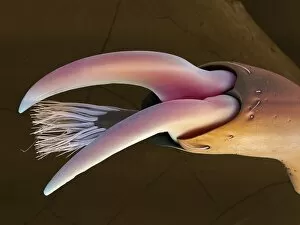Hercules Beetle Collection
The Hercules Beetle, also known as Dynastes hercules or Scarabaeus hercules
All Professionally Made to Order for Quick Shipping
The Hercules Beetle, also known as Dynastes hercules or Scarabaeus hercules, is a magnificent creature that has captivated the attention of naturalists and entomologists for centuries. Its impressive size and unique features make it a fascinating subject for study and admiration. One can trace the fascination with this remarkable beetle back to 1852 when an old litho print was created. This artwork, found on page 444, showcases various names given to the Hercules Beetle throughout history - from The Bronze Beetle to The Hoary Beetle, reflecting its majestic appearance. Another intriguing depiction is an unidentified blue beetle from 1810-17, captured in watercolor and manuscript text. A black-and-white photograph taken at London Zoo captures the essence of a male Hercules Beetle resting on bark. This image highlights its robust physique and intricate details while offering a glimpse into its natural habitat. The Herkuleskafer chromolitho adds vibrancy to our understanding of this species' beauty. Meanwhile, colored engravings such as "Great and rare foreign beetles" and "Beetles" provide visual representations that showcase their stunning diversity. An engraving dating back to 1833-39 portrays the Hercules Beetle in all its glory – vibrant colors accentuating every curve of its exoskeleton. Similarly captivating are colored engravings featuring strange insects; among them stands the mighty Hercules Beetle. Noteworthy is Major Ox's portrayal - an Elephant or Hercules beetle displaying prominent horns - Strategus aloeus observed in wild Florida. Such images serve as evidence of nature's ingenuity in creating diverse adaptations within species. In comparison with other colossal beetles like Titanus giganteus on one side and Dynastes hercules on the other, we witness nature's mastery at work through these incredible creatures' existence. From ancient litho prints to modern photographs capturing their magnificence up close, each representation contributes to our understanding and appreciation of the Hercules Beetle.






















